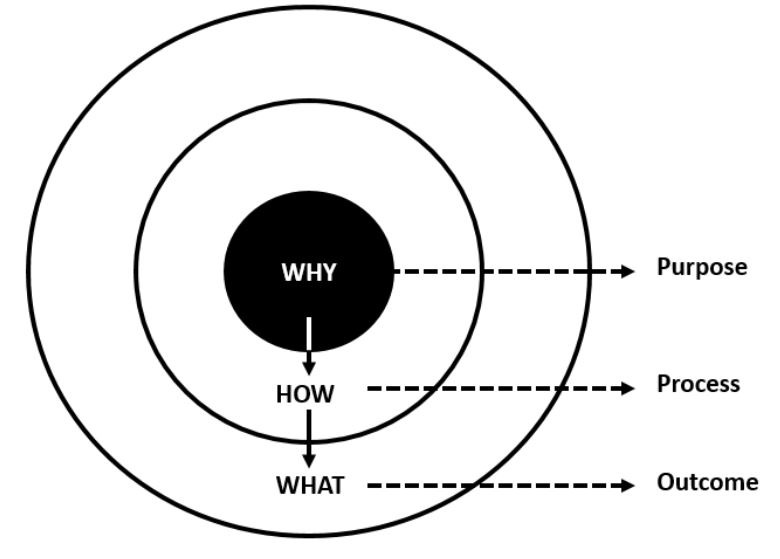Last week’s blog post we discussed “Thinking inside the Box”. In the book “Start with Why” by Simon Sinek, he introduces The Golden Circle. According to Sinek, starting with the why is thinking and communication from the inside out.
Great leaders INSPIRE action. This is achieved by communicating the “WHY” – the purpose behind WHAT they are doing. Clear communication about “WHY” companies and people do what they do makes for stronger companies and stronger economies. When leaders inspire, others will believe in you and your company and stick with you through thick and thin. This kind of loyalty is earned. A great example is Apple. Whenever Apple releases a new product people will stand in line and pay thousands of dollars to be the early adopters, the first ones to own the newest device.
The Golden circle concept applies not only to business but also to our individual lives. When we are inspired the decisions, we make are more about who we are. Can you answer “WHY” you get up in the morning to go to your job. If your answer is for the paycheck then that is not the “WHY” that is the “WHAT”.
The Golden Circle

WHY:
The Belief, the purpose behind what you are doing.
How:
The actions taken to realize the WHY.
WHAT:
The outcome. The product, service, job, or function. Provides tangible proof of your purpose.
The same goes for a company, if an employee says the company exists to fulfill the customers’ needs that is the outcome… but “WHY” does the company exist. When Apply marketed the iPod they said “1000 songs in your pocket” providing the “Why”. People don’t buy “What” you do; they buy “Why” you do it.
Every company, every person has a different “WHY”. For example, what motivates a person to take the risk and start their own business? Why does a person leave a job and return to graduate school? Bill Gates, had the vision that every individual was to have a personal computer on their desk, this was his “Why”. For me, grad school was to improve myself and be able to provide better for my family. My dream of earning my MBA drove me, regardless of how difficult it was to balance full-time work, single parenting, and grad school. I wanted to improve and challenge myself; self-improvement was my “Why”.
The difference between Achievement and Success is that ACHIEVEMENT is something you strive towards, a goal. SUCCESS is a state of being. SUCCESS is the WHY. I achieved my goal, earned my MBA and I felt successful. I did something difficult and conquered that mountain. You do not have to be a millionaire or a billionaire to be successful. Mother Theresa or Gandhi were successful. They did were not millionaires, they did not have big homes or fancy cars, they lived in poverty yet they impacted other people’s lives. They knew their “WHY”, the purpose that drove them to leave the world a better place.
We, as humans have faults and weaknesses, doubts, and insecurities that can limit our imaginations when it comes to our future. Sometimes we don’t imagine all the possibilities and choices that can come by striving to challenge ourselves.
The difference between a manager and a leader is that the manger can lead people in the processes of the business, the Leader inspires people to trust and follow their decisions. The Leader motivates people to be their best selves, be the best employees. Great companies don’t hire skilled people and motivate them, they hire already motivated people and inspire them. When employees belong, they will guarantee your success. People with motivation have positive attitudes and are optimistic. Companies with a strong sense of “WHY” can inspire their employees, who are then more productive, innovative, loyal. The goal is to hire those who are passionate about your “why”, your purpose, cause, or belief, and who have the attitude that fits the culture, Southwest Airlines hires employees on the “why”.
Behind every “Why” type of leader, is a “How” leader who brings the “Why” to life. The “Why” leaders (visionary) need the “HOW” leaders. These are the senior executives who develop the process and bring the leaders’ vision to life. They are practical and more realistic. The “How” leaders work in tandem to be successful.
Recently I was able to be a part of a discussion about the Eeyore’s in some companies. Eeyore’s know the “What”, they do their jobs well but do not understand the “WHY”. As employees gain knowledge and experience within a company they are often promoted within. After all, we want employee retention. Unless all employees understand and believe in the “WHY”, they become nothing more than managers and not leaders.
Leaders inspire and you will want to communicate the “WHY” always. This means that you will be the broken record. Constantly repeating over and over the “WHY”. Creating great products or services is not enough in today’s marketplace. Companies need to lead people and continue to inspire the younger generation. If you’re struggling the Eeyore’s or have high employee turnover, start with making sure that everyone knows the “WHY” of your business. As a leader be sure that your goal is to INSPIRE others.
Employees and managers that understand and believe in the “WHY” will make better decisions, those decisions will all lead back to ensure that they are aligning with the “WHY”. The “Why” is within you. Once you find and know your “Why” keep it clear year after year. You are your best competition.
References
Onyishi, U. (2020, March 16). The 3 lessons I learnt from reading start with why by Simon Sinek. Retrieved from https://medium.com/bookish-phdlife/the-3-lessons-i-learnt-from-reading-start-with-why-by-simon-sinek-3f194d691bf4
Sinek, S. (2011). Start with why: How great leaders inspire everyone to take action. Penguin.
Sinek, S. (n.d.). Simon Sinek – Start with Why. Retrieved from https://www.youtube.com/watch?v=IPYeCltXpxw
